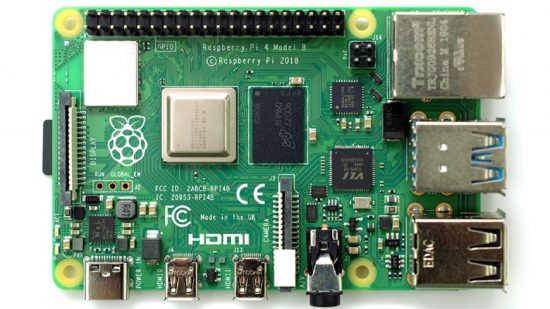Although everyone knew it was coming, nobody expected it quite this quickly: the Raspberry Pi is dead, long live the Raspberry Pi. To clarify: as indicated during the launch of the Raspberry Pi 3 Model A+, the ‘legacy’ Raspberry Pi range has come to a close.
Its replacement, looking not wholly dissimilar and going under the name Raspberry Pi 4, is a ground-up reengineering effort which aims to finally address some of the most long-standing complaints about the low-cost, education-focused single-board computer family.
The heart of the effort is a new system-on-chip (SoC), the Broadcom BCM2711B0. The headline-grabbing features are four 1.5GHz ARM Cortex-A72 CPU cores and an all-new VideoCore VI GPU – making it the first Raspberry Pi in history to launch without the ageing VideoCore IV.
Inside, there’s an even more welcome. The primary bottleneck of the Raspberry Pi design, from the original Model B right through to the range-topping Raspberry Pi 3 Model B+, has gone. The SoC now enjoys around 5Gb/sec of bandwidth to connect with external devices, instead of trying to shove everything through a single 480Mb/sec USB lane.
That has a serious impact on the Raspberry Pi’s capabilities. Where the four USB 2 ports would previously have shared bandwidth, not only are they now fully independent, but two of them have now been upgraded to USB 3. Likewise, where the ‘Gigabit’ Ethernet of the Raspberry Pi 3 Model B+ would top out at around 250Mb/sec, the Pi 4’s port gets about as close to Gigabit speeds as you could hope.
There’s still more to the Pi 4 as well. The shift to an all-new SoC has broken the 1GB memory barrier, with the Pi 4 launching in 1GB, 2GB and 4GB varieties – and it’s all LPDDR4 memory, rather than the older models’ LPDDR2. The upgraded GPU now also includes dual-display capabilities, with the board design trading the traditional full-size HDMI port for a pair of micro-HDMI connectors, each able to drive a 4K display – either a single 4K60 or two 4K30 panels. Plus there’s a hardware decoder for HEVC (H.265) content, capable of decoding 4K60 content to boot, though all other formats are limited to lower resolutions.
While the Pi 4 looks superficially similar to its predecessors in terms of layout, there have been some considerable shifts. The top pair of USB ports and the bottom Ethernet port have now changed places, there are now two micro-HDMI connectors in place of the single full-size HDMI port, and the micro-USB power connector is now a USB Type-C connector, boosting the board’s maximum input current to 3A. Each port also now sits a little prouder of the board, which means you’re unlikely to squeeze a Pi 4 into an existing case without considerable modification.
Surprisingly, though, for all project co-founder Eben Upton warned of a clean slate plan following the last of the ‘legacy’ family, compatibility is good. Raspbian ‘Buster’, released alongside the board, boots on any Raspberry Pi from the Pi 4 going all the way back to the original Model B. The new board is also fully compatible with add-ons adhering to the Hardware Attached on Top (HAT) standard, and accessories such as the Raspberry Pi Touch-Screen Display and Raspberry Pi Camera Module connect without difficulty.
The changes aren’t just tick-boxes on a spec sheet either. Processor-wise, the Pi 4 is considerable faster than the Pi 3B+ across a range of workloads. It’s around four times faster in the LINPACK benchmark, twice as fast at multi-threaded file compression and around a third faster in a GIMP-driven image editing challenge. The GPU provides a solid boost, too, pushing half again as many frames per second in the OpenArena first-person shooter as its predecessor.
It gets interesting in workloads that were previously fighting the USB bottleneck, though. The Ethernet throughput has quadrupled from around 240Mb/sec to 943Mb/sec, while USB storage throughput has risen by an order of magnitude from 33.24MB/sec read and 34.1MB/sec write – dropping if you’re transferring data over the network at the same time – to 363MB/sec read and 323MB/sec write. Even the micro-SD storage enjoys a boost thanks to the addition of DDR support, going from 23.5MB/sec read and 17.4MB/sec write to 45.7MB/sec read and 27.7MB/sec write.
There’s a cost, naturally: power and its friend heat. The Pi 4 runs hot, with thermal imaging showing heat spreading throughout the board. This heat comes from increased power draw. When idle, the Pi 4 draws 3.4W, compared with the Pi 3B+’s 2.9W, though this figure may fall with post-launch firmware optimisations, while under load it hits 7.6W.
It’s a small price to pay, though your wallet will feel the difference in RAM capacities. Pi 4 pricing sits at around £34, £44, and £54 (inc VAT) for the 1GB, 2GB, and 4GB models respectively, from resellers including pimoroni.com.
Price
$35
Raspberry Pi 4 specifications
- SoC Broadcom BCM2711B0 quad-core A72 (ARMv8-A) 64-bit @ 1.5GHz
- GPU Broadcom VideoCore VI
- Networking Dual-band 802.11b/g/n/ac Wi-Fi, Gigabit Ethernet
- Memory 1GB, 2GB or 4GB LPDDR4 SDRAM
- Bluetooth Bluetooth 5, Bluetooth Low Energy (BLE)
- GPIO 40-pin GPIO header, populated
- Storage Micro-SD
- Ports 2x micro-H DMI 2, 3.5mm analogue audio-video jack, 2 x USB 2, 2 x USB 3, Gigabit Ethernet, Camera Serial Interface (CSI), Display Serial Interface (DSI)
- Dimensions 88 x 58 x 19.5mm
- Weight 46g
